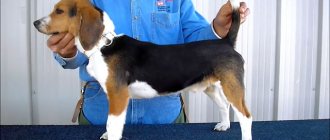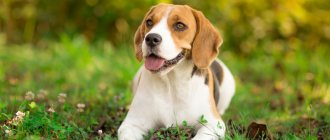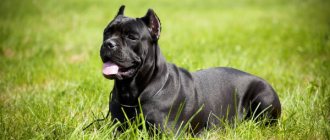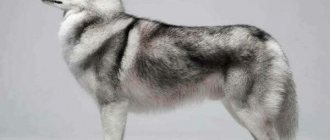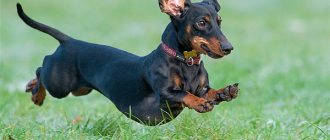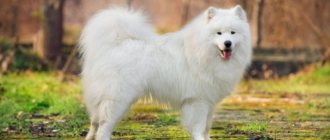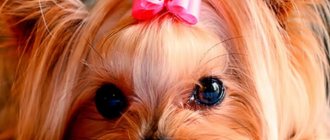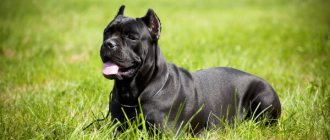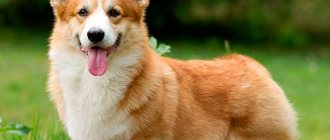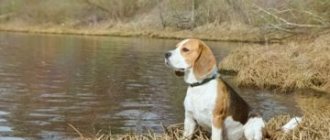- Dogs
| Data from users of the site pets-mf.ru | ||||||||||||
| Age (months) | 1 | 2 | 3 | 4 | 5 | 6 | 7 | 8 | 9 | 10 | 11 | 12 |
| Weight, kg) | — | — | 8 | 7 | — | — | — | — | — | — | — | 13 |
| Height (cm) | — | — | 28 | 35 | — | — | — | — | — | — | — | 31 |
The Beagle is a well-known and very popular dog breed in many countries, which has a strong external resemblance to the Foxhound, but is distinguished by its smaller size, rather short legs and long ears. The breed belongs to a common group of hound dogs.
The Beagle is one of the very ancient, truly English breeds, the origin of which is currently not known for certain. Today, there are several versions regarding the origin, but all of them do not have convincing documentary evidence. The earliest surviving information about the use of the beagle in hunting belongs to the little-known Greek dictionary Onomasticon, compiled by Julius Pollux. The document dates from the second century AD.
Basic moments
The Beagle instantly captivates with its remarkable charm. A dog's hazel eyes look straight into your soul, especially if the animal intends to beg you for a tasty morsel. The charming appearance of the fidget is in perfect harmony with his character, so you should not expect meekness and calmness from the beagle. Despite its moderately short legs, the dog can develop high speed when chasing a pigeon or a neighbor's cat. Beagles are very active by nature. For this breed, there is no better entertainment than a walk in the city park. Bring a frisbee or tennis ball with you and your dog will be happy.
How much does a Beagle need to eat per day?
Up to 6 months, a beagle puppy should eat 3 times a day. Then twice a day from 6-12 months. Then, after a year, they should eat one meal a day.
Adults can be fed twice a day, but their portion should be divided into two and no more.
The amount of food an adult Beagle should eat is approximately 180-220 grams, which can be divided into morning and evening meals.
Meal time is not something Beagles struggle with as they will eat anything. However, it is important to follow the recommended diet.
© shutterstock
Keep in mind that feeding dog food high in additives and dyes may cause your beagle to react poorly. Look for organic products whenever possible.
As your Beagle ages, it will become less active, so it's best to avoid foods high in protein.
Characteristic
Beagle puppies (photo below) are small, brave and inquisitive explorers. With a bright temperament and good health, a true beagle should not be cowardly, angry or lethargic.
Beagle puppies captivate with their charming appearance and endless love for the world around them. They love children, toys and outdoor games. They are distinguished by their intelligence, know how to be cunning and attract attention.
By nature, little beagles are real optimists and fidgets who will not let you get bored. The Beagle is curious, playful and persistent. He can tirelessly run after the ball, poke his nose into everything, jump and gallop, while bursting into loud barks.
The beagle puppy radiates happiness and positivity; despondency and boredom are unknown to him. He will become a companion for active people with a sense of humor, but he will quickly tire of homebodies and childish individuals.
TOP nicknames
Choosing a nickname is one of the most stressful and time-consuming activities associated with acquiring a four-legged family member. At first glance, it seems that you can name a puppy purchased from a breeder by the name that was assigned when the litter was activated. But practice shows that such names do not take root, although they may be included in the animal’s passport.
The wisest decision is to take a wait-and-see approach. Spend a couple of days observing your dog, and its behavior will certainly tell you a suitable name. You can consider the following nicknames as options.
For "girls":
- Amanda;
- Gabby;
- Daisy;
- Julie;
- Lyme;
- Linda;
- Rixie;
- Tina;
- Flora;
- Hilda;
- Elsa.
For boys":
- Harold;
- Gordon;
- Denis;
- Quint;
- Kenya;
- Cleo;
- May;
- Oscar;
- Richard;
- Rocks;
- Hoop.
Hygiene procedures
One of the advantages of beagles over other dog breeds is that they are very playful and active. However, it must be taken into account that such animals need regular care for their eyes, ears, claws, paws and, of course, fur.
You should always pay attention to the condition of the animal’s eyes, since they are one of the indicators of the dog’s health. Lumps of discharge may form in the corners, but they are small. They need to be removed with cotton pads, soaked in tea leaves, clean, slightly warm water or chamomile decoction.
You should always look at the condition of your ears. They need to be kept clean, and to do this, use special products for the ears. Cotton swabs are used for cleaning.
It is very important to monitor the condition of your pet's paws. If the dog usually walks on soft surfaces, then the claws, of course, will grow quickly. Because of this, they cause a lot of discomfort to the dog. To prevent this problem, you should purchase a special device in the form of nippers to trim the claws. Paw pads should always be washed with water after going outside, especially after winter walks, as the paths may be sprinkled with chemicals. If cracks appear, creams must be used. You rarely need to wash your dog - only before competitions or if he is very dirty. This is approximately 4 times a year.
How do I know if my beagle is overweight?
There are several ways to determine if your beagle is overweight. You can monitor their weight using a dog scale. Or you can do a visual assessment.
Looking from above, check if the ribs are sticking out, you can also feel the ribs under their fur, this should indicate the correct weight. Also check their spine, it is covered with a thin layer of skin. If you can easily feel it through their skin, then they are healthy.
If it's harder to find, then they're probably carrying a few extra pounds.
Their waist should also be defined and not sagging; if they have fat, it will be visible around the chest and at the base of the tail.
Beagles, being hounds, will run and exercise and this gives them strong muscles. This exercise should sharpen their body. If your puppy looks bulky and heavy, you need to put him on a diet right away.
Another easy way to tell if your beagle is carrying extra weight is if he struggles on walks.
If they begin to pant more often than usual or become less energetic, this may be a clear sign that they are overweight.
All dogs love to be groomed. If your beagle takes less care of himself and is having difficulties, this could also be a sign of weight gain.
Training
The stubbornness and love of freedom of beagles significantly complicates the educational process. But according to dog handlers, training should begin from a very early age. Until one year of age, stubbornness in dogs is especially pronounced.
- Use the “carrot” method When starting training, be patient and give him treats. For every correctly executed command and act of obedience, give your dog a treat. Otherwise you won't be able to reach an agreement with him.
- Forget about the "stick" method. These dogs remember any negativity associated with their upbringing. Therefore, do not try to scold them or, even worse, beat them. At the next lesson, the animal will definitely remember the aggression shown towards it and will act in the same way.
A special slingshot and several yellow tennis balls are a real must-have for the “beagle owner.” Throwing a stick at a dog endlessly is too tiring. And a slingshot will allow you to throw your “prey” quite far. Chasing the ball, the animal runs to its heart's content. And the owner will not get tired and will save energy for other things.
Dental care
Milk teeth appear in beagles by 1 month, and at the age of 3-4 months they begin to be replaced by molars. This process lasts up to six months, sometimes longer.
During this period, the dog needs toys that it can chew on, as well as various hard treats.
The change of teeth should be monitored and if abnormal growth of molars, wounds or swelling in the pet’s mouth is detected, it is necessary to show it to a veterinarian.
To avoid problems with teeth and gums, you need to brush your dog's teeth weekly with a special soft toothbrush and toothpaste. To brush a beagle's teeth, you need to open its mouth slightly with one hand and brush from the base of the tooth to the edge.
Possible diseases
An active beagle with a good appetite is a sign of health. In each region there are the most common diseases for dogs, in which case it is necessary to vaccinate against them. Beagles can get the following diseases:
Beagle loves to chew sticks
1. Disease of the ears is dictated by their large size and drooping condition. Bacteria and fungi contribute to the development of otitis media. The complication leads to disruption of the vestibular apparatus and inflammation of the brain. Preventative examinations will help to eliminate and prevent them in time.
2. Eye diseases. Among them there is a “cherry eye”. Symptoms: the appearance of cherry edema in the lower part of the eye. Causes: The glands of the third eyelid can be torn out during hunting or fighting. Treatment: surgery only.
3. Glaucoma, accompanied by intracranial pressure. Symptoms: enlarged eyeball, loss of appetite, no contact with household members. Reasons: genetic predisposition from ancestors, age (more than 6 years), breed, chronic inflammatory processes of the eyes. Treatment: drops to relieve pressure, surgery.
4. Cataract. Symptoms: cloudy eyes. Treatment is surgery.
5. Epilepsy. The cause of the disease can be stress, hypothermia, difficult childbirth. Symptoms: the pet suddenly falls and twitches in convulsions, eyes point in one direction and freezes, may defecate, foams at the mouth.
The duration of the attack is 5-15 minutes. The owner’s help in this case is not to press him to himself or to a surface, but to raise his head with his hand and protect him from injury. Sometimes I get convulsions from high fever, and there is a possibility of confusing the two diseases. Therefore, it is important for your veterinarian to make the correct diagnosis. Treatment: medications for seizures and diet are prescribed.
6. Diabetes. Symptoms: weight gain, urinating frequently, the dog is not active, losing vision, constantly thirsty. Over time, with increased appetite, he begins to lose weight. Treatment: the veterinarian prescribes insulin and diet.
7. Chronic hepatitis. It can be in two versions: infectious, toxic. If acute hepatitis is not cured, incurable chronic hepatitis takes its place. Symptoms: the dog is not active, does not eat, interest in the game disappears.
When the liver is damaged, the tonsils, heartbeat, and liver become enlarged, the whites of the eyes become yellow, and the stool becomes white. Treatment: a course of medication is prescribed depending on the stage of the disease, diet.
8. Disease of the intervertebral discs. Symptoms: reluctance to move or climb to heights, unsteadiness of gait. The body is being diagnosed. Treatment can be conservative or surgical.
9. Lymphosarcoma. Symptoms: weight loss, enlarged lymph nodes, the dog stops eating, becomes lethargic, indifferent to play. Chemotherapy treatment will prolong life by several years. If you do not resort to this method, your pet will face a sad end in 2 months.
10. Dermatitis. Symptoms: itching that accompanies the dog scratching the skin, redness forms. The cause may be parasites, allergies, endocrine disease, etc. Treatment: The doctor identifies the type of dermatitis and prescribes appropriate treatment.
How to choose your future pet?
If you decide to choose a beagle puppy, first of all you need to pay attention to its physical condition.
In a healthy beagle:
- shiny thick coat evenly covering the body, no bald patches or dandruff;
- scissor bite;
- the nose is moist and cold, pigmented black, without discharge;
- the mucous membranes of the mouth are pale pink;
- the paws are strong, there are small seals in the area of the knee joints, there are no dewclaws;
- the eyes are shiny, the ears are clean, there is no discharge or odor;
- The male has 2 developed testicles, no signs of cryptorchidism.
The puppy must move confidently and be active, curious, and cheerful.
In males, stubbornness and independence are more pronounced - a boy is usually more difficult to educate and train, and is inclined to run after prey and a female in heat.
Bitches are more affectionate and obedient; training girls is much easier. Among their disadvantages are regular estrus, when they become the object of hunting by males. Also at this time they may experience changes in behavior.
NOTE!
If a dog is purchased for hunting, then there is no difference between a male and a female - the hunting instinct is equally developed in both sexes.
It is better to purchase a puppy from a specialized nursery after learning about the conditions of their care and the health status of the parents.
In case of purchasing a purebred representative of the breed, the breeder is obliged to present all the necessary documents:
- pedigree;
- birth certificate;
- veterinary passport;
- inspection report;
- application for registration in the club.
Photo review
Curiously raised ears, intent gaze and a body as if on springs - photos of beagles make you fall in love with the breed at first sight. These guys require a lot of attention, but in return they are ready to pay with boundless love and devotion to the owner and his family members. And if you hear a dog barking loudly while in the house, rest assured: he requires your affection.
Puppy development and growth
The development of a small beagle can be simplified into several stages:
- 1-2 month. Differences in the development of males and females appear. Animals take on the traits of their parents.
- 3-6 month. There is an increased increase in mass. The kitten develops a chest, and its legs become strong and powerful.
- 6-12 month. The animal acquires all the external characteristics of an adult dog.
As representatives of a miniature breed, beagles stop developing much earlier than large dogs - on average, by the 9th month of life. At this stage of development, the growth of the long bones is completed. In other words, by 9 months the beagle reaches its final height. Then the dog will only “grow” in width - gain weight, build up muscles.
The development of boys and girls is uneven. In females, growth stops with the first heat. In males it lasts a little longer, since it is not associated with puberty.
Breed Standard (FCI)
The Beagle is a hunting dog breed that originated in Great Britain. Due to its excellent sense of smell and high speed, it has long been used for catching small game such as rabbits and hares. Now the beagle is a companion dog that is suitable for both active and calm people, families with children, and the elderly. Sometimes it is used by customs to search for explosives.
Externally, the dog is similar to a foxhound, but smaller in size and with longer ears. Its peculiarity is that it does not require special care and is very unpretentious in maintenance. Although their training requires patience and understanding due to their stubborn, headstrong nature. At the same time, high intelligence, activity and cheerfulness make the Beagle a good companion for any person. Dog breeders value them for their sociability, flexible mind and cheerful, optimistic disposition.
Photo from Instagram account irina_mazhor
The breed standard clearly defines how much an adult beagle weighs, what its height is, the shape of its head and body, acceptable color, temperament, etc. You can buy different puppies, but only those that meet all the characteristics are considered truly purebred.
According to the breed standards of the RKF and FCI, the Beagle belongs to the group of hounds that follow the blood trail, to the section of small-sized hounds. According to requirements:
- Outwardly, it is a strong and compact hound, which does not show signs of coarseness, but at the same time gives the impression of strength. The length of the forelimbs to the elbow should be equal to half the height of the dog at the withers.
- The Beagle's character is cheerful and active. He is resilient and determined. Shows intelligence and balance. Good-natured disposition, but without signs of aggression towards humans or other animals and cowardice.
- The natural purpose is hunting, mainly for hares and rabbits. They pursue game in the undergrowth where larger hunting dogs cannot penetrate.
- The head is proportional, powerful, but not coarse. Girls are more graceful. There are no folds or wrinkles.
- The skull is moderately wide, slightly elongated. The bump on the back of the head is weakly expressed. The stop divides the head from the mound at the back of the head to the tip of the nose exactly in the middle or as close to it as possible.
- The muzzle is not pointed. The nose is wide, preferably black. Lighter pigment is only acceptable for light-colored dogs. Wide nostrils. Jowls are expressed in moderation. The jaws are strong, the bite is perfect. The upper incisors should closely overlap the lower ones and stand vertically. The eyes are hazel or dark brown, large, moderately widely spaced. The look is soft and pleasant. The ears are long, reach to the tip of the nose, and fit tightly to the cheekbones. Long, ends rounded. Soft to the touch.
- The neck is long, thanks to which the dog can easily follow the trail, with a slight bend.
- The top line of the body is smooth and straight. The body is short in the lumbar region, but fairly balanced. The chest is lowered lower than the elbows. The ribs are curved. The stomach is not too tucked. The loin is short, strong and flexible.
- The tail is of medium length. Thick, set high. It doesn’t twist, but it doesn’t point forward either. Covered with fur, this is especially evident on the underside.
- The front and back paws are strong and collected. Fingers are compact with short claws. The pads are dense.
- The thighs are muscular and strong. Knees with a well-defined angle. The joints are strong, parallel to each other and low located.
- The back shows no signs of “rolling.” It is straight and strong. The dog's step is free, it grasps space well with its front paws. Movements are straight, limbs are not raised high. The rear ones push off well. They should not come together, and the front ones should not rake or braid.
- The coat is short but dense. It protects well from bad weather and does not get wet for a long time. Different colors are allowed: solid white, white with red and black, white with red and blue, badger, black and white. Others are a deviation. The tip of the tail is always white.
- The height of a beagle at the withers is no less than 33 centimeters and no more than 40 centimeters.
Any deviation from these characteristics is a fault or defect in the dog. The more pronounced they are, the more serious they are considered. The assessment also takes into account how these deficiencies affect the dog's health, ability to perform work and psychological well-being. Most often, their influence is minimal, although for competitions this is a stopping factor.
Vices that are considered grounds for disqualification include aggressiveness, cowardice and obvious physical or psychological abnormalities. In male dogs, attention is also paid to the presence of two fully developed testes descended into the scrotum. Only healthy, strong dogs that have all the characteristics characteristic of the breed are allowed for breeding.
In addition to strict compliance with standards, a dog’s thoroughbred is determined by several other criteria:
- the beagle should have a beautiful head with large eyes and an intelligent, clear look;
- body structure – athletic. Excessive thinness or the appearance of a tummy negatively affects the appearance of the dog. It is especially worth monitoring excess weight, since beagles do not always feel moderation in food and are prone to obesity;
- Representatives of the breed should have a black border around the eyes.
The breed of a dog also determines its character. First of all, a beagle must be friendly. His adherence to rules and good manners are also important. To do this, you need to educate him from childhood. It is important to teach the dog commands, show who is the leader in the house in order to pacify his stubborn temper, and begin socialization from the very first months of life. It is worth playing with your dog regularly and giving it moderate exercise so that it can expend a large supply of natural energy.
Factors influencing growth
Throughout the pet’s life, and especially during puppyhood, the owner must monitor the effects of factors affecting the development and health of the dog:
- The general condition and strength of the beagle's immunity depends on its intrauterine development and quality of care in the first 6 months of life. Therefore, the owner does not ignore the weakest puppies in the litter - he applies them to the rear nipples of the mother dog, and if there is a lack of milk, he buys a special artificial formula (for puppies, not for children).
- The main conditions for the development of any dog are keeping them in a warm, dry room, active life, walks in the fresh air, and feeding them a balanced, high-quality diet.
- You should not treat your kitten with delicacies from the human table - sweets, fried meat and cutlets, smoked sausage, flour products. If you want to pamper your beagle, you should offer him a piece of cheese, an apple, or a carrot.
- Up to 3 months, puppies are fed 6 times a day, up to 4 months - 4 times, up to 5 months - 3 times, after 6 months - 2 times.
- When compiling a menu for young animals, the emphasis is on carbohydrates and protein - the bare minimum of fat. The food must contain fiber, calcium, and vitamins A, E, and D.
- The puppy is provided with round-the-clock access to fresh and clean water - its lack results in problems with the gastrointestinal tract, constipation and even developmental inhibition.
- By 7 months, a young dog should have 42 permanent teeth in its mouth. If the dentition is incomplete and the enamel is fragile, the animal is prescribed medications containing calcium, phosphorus, vitamins A and D.
Control of food intake
Beagles are prone to overeating, so you need to keep an eye on how much food they eat. Otherwise, obesity will develop. To protect your pet from such problems, you must always think through his diet, monitor portion sizes and frequency of food consumption. The portions need to be small, since the dog itself is not large.
Caring for a Beagle puppy is not difficult.
Exercise stress
In general, beagles are physically strong and energetic dogs. They will never have enough active walks.
However, when it comes to puppies, the owners' observation is important.
Excessive physical activity such as agility will negatively affect the baby’s health and can damage his fragile ligaments. The dog should return home tired, nothing more.
A vaccinated puppy can be walked in any weather, it is advisable to use an anti-tick collar .
But we need to focus on the baby’s age: the younger he is, the shorter the duration of going outside should be when it’s cold.
There are no clear standards on this issue; each animal is individual. The attentiveness of the owners is above all.
The kid dreams of being like Jordan in the future
